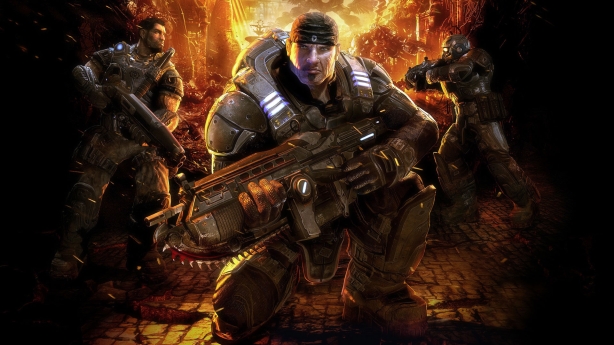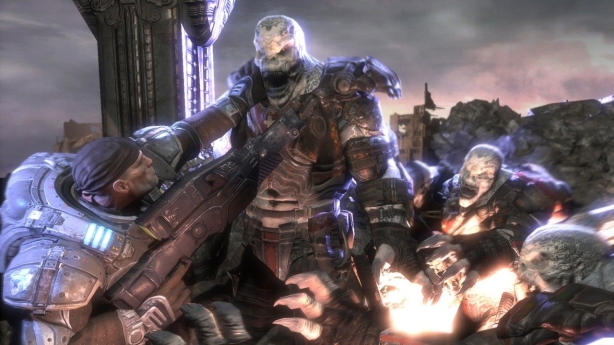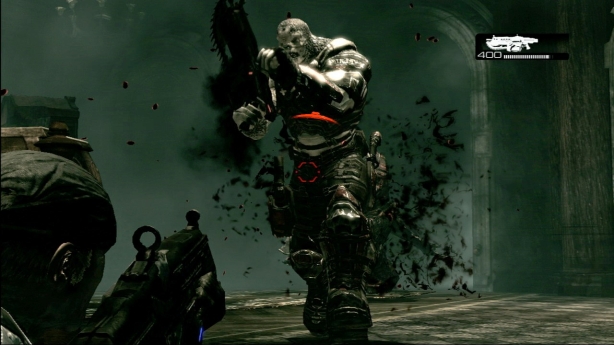Them’s The (Beer) Breaks: What Sex And The City Says About Plot In Gears of War
 Back in 2006 when I first fired up Gears of War, I realised there was something oddly familiar about it. Try as I might, I just couldn’t work out what it was. Despite its similarities to classic shooters such as Doom and Contra, Gears of War’s four wisecracking marines called to mind a franchise that was altogether different.
Back in 2006 when I first fired up Gears of War, I realised there was something oddly familiar about it. Try as I might, I just couldn’t work out what it was. Despite its similarities to classic shooters such as Doom and Contra, Gears of War’s four wisecracking marines called to mind a franchise that was altogether different.
Then, it hit me. Four preposterously attired central characters horsing about in a fantasy environment? A complete disregard for believability and coherent plot in favour of amusing hijinks and bodily fluids? But of course! Gears of War is basically just a post-apocalyptic version of Sex and the City!
No really. Stick with me on this one, GodisaGeek readers. I know you are an open-minded and intelligent bunch. Besides, there probably isn’t a lot of cross-over between fans of Gears of War and fans of Sex and the City (though I am happy to be proved wrong), so you just might learn something.
With all that in mind, the differences between the two franchises are more immediately apparent than their similarities. Whilst Gears of War is a story about an alien war set on a fictional post-apocalyptic planet, Sex in the City is a story about getting laid set in modern-day Manhattan. Gears of War is painted exclusively from a palette of dystopian greys, whereas Sex and the City is saturated with saccharine candy colours, and whilst Gears of War features four elephantine men strapped into approximately two tonnes of metal apiece, Sex and the City stars four waif-like women who seem incapable of remaining in the same outfit for more than twenty minutes, and sometimes don’t manage to wear any clothes at all.
Yet, despite the enormous superficial differences between these two preposterous franchises, their similarities run deep, and tell us more about effective storytelling in video games than we might first imagine.
The most important message is that storytelling should be kept to a minimum where it is not required. What’s important in Gears of War is shooting, stamping and chainsawing Locust into a bloody pulp, and the “plot” is merely a means to this glorious end. Consequently, the game’s centrepiece, campaign mode, is at its finest when played co-operatively with a friend and several pints of fine ale.
Epic’s clear-headed understanding of its target audience led to the inspired structure of the game; intense battles interspersed with “beer-breaks”, nuggets of non-interactive plot just long enough for a couple of swigs of aforementioned ale. Individual checkpoints are alternated with sequences where Marcus Fenix and Dominic Santiago must slow to a walk and listen to bits of shameless exposition from Anya, the Gears’ controller in the CIC. Unable to draw weapons or interact with the environment during these instances, the player has an opportunity to kick back and enjoy their pint.
You see, although you might imagine that Gears of War’s “plot” is intended to provide the action with context, you’d be wrong. It doesn’t matter why Marcus, Dom, Cole and Baird kill locust in a city or a factory or a mine, just that it is fun. Instead, the plot exists to punctuate and structure the action, ensuring that players are ready to enjoy each individual battle. So effective are the morsels of dialogue that the player knows precisely when to anticipate an ambush or prepare themselves for an almighty shoot-out. The meat of the game lies in its battles, and its dialogue and cut scenes are its two veg, a token gesture towards balance and a healthy digestion.
Moving on.
Sex and the City employs a similar technique. This series is all about the set-pieces; outfits, cheesy puns and choreographed sex-scenes, and yet a diaphanous shroud of plot must be draped over all these disparate elements if they are are to function as a coherent sequence of episodes. It doesn’t matter why the women find themselves in awkward situations with various unsuitable men, just that those situations are fun to watch. Just as it doesn’t matter why the Locust are fighting the Lambent Locust in Gears of War, just that the Lambent explode in a hail of fluorescent Emulsion when Marcus runs them through with his chainsaw.
It’s for this reason that both Gears of War and Sex and the City feature almost exactly the same cast. The core four characters that roam both the planet of Sera and the city of Manhattan have long been established by popular culture as an effective means of guiding a viewer through comic set-ups, especially those as lightweight as the ones in Gears of War or Sex and the City. This technique is also used to great effect in South Park and Red Dwarf, which I’ll mention if you’re in the unfortunate position of never having watched Sex and the City. Ahem.
Broadly speaking, these four characters conform to the following types:
A hero, leader, or protagonist, who provides the story’s anchor. In the case of Gears of War, this character is Marcus, the grumpy but noble soldier whose wrongful conviction at the start of the first game adds weight to proceedings. In Sex and the City, this character is embodied by the ponderous Carrie, whose narration provides the links between the various escapades in each episode of the show. South Park’s leader is everykid Stan, whose love of video games and conventional family life (violent sister and idiotic father notwithstanding) provide a centrality to the show’s bizarre goings-on, and Red Dwarf’s core of wistful yearning is provided by curry and beer-obsessed Lister, the last human in the galaxy.
Next up, a buddy or conscience who provides support and emotional weight to the protagonist’s plight. Dominic Santiago is not only an effective “Player B” in Gears of War’s campaign mode, but in his tragic quest to be reunited with his wife Maria, he provides the sub-plot to the second game. Charlotte’s desire for domestic bliss is the flip-side to Carrie’s quest for Mr. Right, Kyle Broflovski’s perpetual outrage offers a moral counterpoint to the South Park escapades and Kryten’s naïve sense of duty emphasises Lister’s lazy and mischievous existentialism.
The antagonist character exists to provide conflict within the central core of characters. Gears of War’s antagonist is Baird, who spends the majority of the time either complaining or insulting the other members of Delta Squad. In Sex and the City, the cynical Miranda frequently opposes the decisions of her more idealistic friends. South Park’s Cartman exhibits relentlessly appalling behaviour, and Rimmer’s open contempt for Lister’s laziness is the source of the show’s best dialogue.
The most lightweight of these tropes is the comic relief, a character who is frequently devoid of depth or complexity. Utterly lacking in both is Gears of War’s Augustus “Cole Train” Cole, whose utterances throughout the game express enjoyment of destruction and not much else (example: “Yeah, woo! Bring it on sucker, this is MY kind of shit!”). Although Sex and the City’s Samantha is given some gravity, her role in the show is primarily to provide the set-up for various acrobatic sex-scenes and so-bad-they’re-good puns about the male anatomy. South Park’s creators describe the frequently dismembered Kenny as being more like a prop than a character, and the one-dimensional Cat exists purely to give Red Dwarf’s costume department something to do.
You could argue that in the context of Gears of War’s gameplay, only Marcus and Dom are required, since the co-operative campaign only enables the participation of two players. However, Cole and Baird balance Delta Squad’s reaction to events, ensuring that for every explosion, every blood fountain, and every river of excrement, there is a corresponding wisecrack to enjoy as you swig your ale.
Without Cole’s silly utterances or Baird’s assertions that everyone around him is an idiot, Dom’s moping and Marcus’ brooding would drag Gears of War down. The game’s raison d’etre is the visceral joy of wanton destruction and whenever the game strays too far from this (i.e. when Dom starts staring wistfully at a photo of his wife), a poop joke swings it right back the other way.
The importance of poop jokes is emphasised by the fact that the first time many of us heard of Gears of War, we were sitting in a cinema in October 2006 when an angst-ridden teaser trailer featuring Gary Jules’ emo smash hit “Mad World” came on screen. It shows Marcus Fenix on his own, running through the rainy and deserted streets of Jacinto before encountering a corpser, looking a bit like a Christmas decoration, in an abandoned building.
It’s a good trailer, but ever so serious. Its wordless portrayal of Marcus as some kind of existential hero suggests a game which asks serious questions about the nature of war, much in the same way that Donnie Darko’s use of “Mad World” asks serious questions about the nature of time and destiny.* Whilst there’s no reason that games shouldn’t pose such interesting questions (and they frequently do), such questions are bound to dampen the glee that we play games like Gears of War to feel. Existentialism just does not belong in a game which rewards headshots with the kind of satisfying pop of goo that you get from squeezing a zit. At best, the head-popping is robbed of its fun, and at worst, the killing becomes loaded with symbolism to the point where you begin to feel a bit uneasy about it, and not in a good way.
Thankfully, the actual game dispensed with all the angst, and as far as we know, Marcus doesn’t write poetry. A good thing too, because the alternative is too awful to comprehend. Gears of War’s plot is just like the beautiful buildings that line the Jacinto streets, nice to look at, sets the scene, but you can’t open the doors, and ultimately, it’s all just scenery.
If the series’ third installment is to enjoy the same blistering success as the first two games, it must remember this. Sex and the City did not, which is why the single best review of the second film begins with the line: “I’m not asking for much. I just don’t want to be sick in my mouth.”
The early episodes of Sex and the City focussed on wit and, erm, sex. They were light and funny, and every episode was enjoyable for its own sake. However, it was not long before the show began its baffling descent into a preoccupation with marriage and babies. It was as if Gears of War’s battles were fought only with water pistols and we had to endure a Freudian journey through Baird’s troubled subconscious.
A game like Gears of War needs a plot. Even though anyone in the mood for a good lancer-fest probably won’t have the attention span for a Bioware-style discourse on politics or morality (for this reason, you will find that Mass Effect cannot be played whilst drunk), players need a little backdrop, some context to the explosions and gore.
As long as Epic remember this and they don’t dispense with sequences set in the aorta of a giant worm in favour of Baird’s quest for a girlfriend, we should be just fine.
*This is what I say at parties to sound smart. In all honestly I have no idea what Donnie Darko is about.
Gears of War 3 is set for a September 20th release, exclusively for Xbox 360. You can read the GodisaGeek Gears of War 3 Beta impressions, right here.








